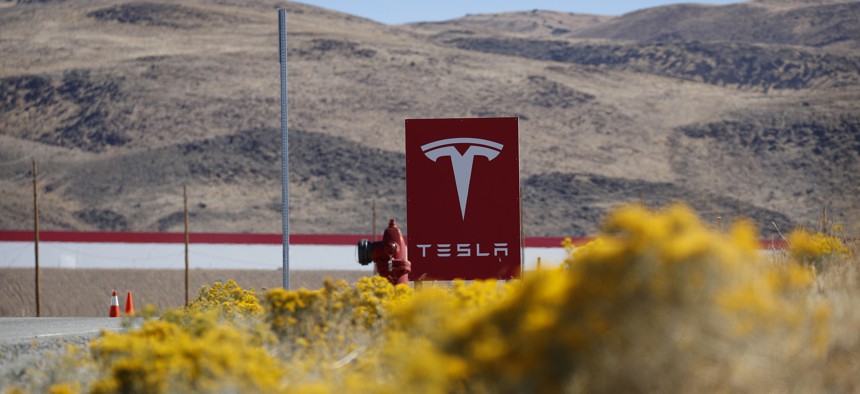The Innovations of the Creative Class Affect a Rural Area’s Fortunes

A sign marks the entrance to the Tesla Gigafactory in Sparks, Nev. A population inrush to Nevada has been driven by people seeking more affordable housing and a growing tech industry around Reno. AP Photo/John Locher
A new study measures innovation and shows that when found in rural areas, it is tied to significant presence of the creative class.
One of the most persistent themes in America is the notion of an urban-rural divide. The legend is that urban areas are dense, diverse, and innovative—home to a disproportionate share of college grads and the creative class, while rural areas face brain drain, lag badly on innovation, and are suffering widespread economic decline. While it is true that innovation and the creative class tend to concentrate in leading knowledge hubs and superstar cities like San Francisco, Boston, Seattle, Washington D.C., and New York City, rural areas can be centers of innovation and talent too.
Even though innovation remains higher in urban areas, a new study finds clear evidence of it in a subset of rural communities, closely tied to the presence of a rural creative class.
The study by researchers at Oklahoma State University and Purdue University uses detailed data from the Rural Establishment Innovation Survey (REIS) conducted by the U.S. Department of Agriculture’s (USDA) Economic Research Service. It is the first nationally representative survey of innovation in rural businesses and communities, covering more than 10,000 businesses in some 2,200 counties, with nearly three-quarters of the responses coming from businesses in rural areas (defined as non-metropolitan counties).
The study uses data from the survey to create an Innovation Index which assesses: intellectual property measures like patents, copyrights, and trademarks; innovative accomplishments like new products and services; and customer focus or feedback. It examines both the effects of innovation on the performance of rural business, and the factors associated with innovative rural businesses including income levels, unemployment rates, and presence of the creative class.
Not surprisingly, innovation is higher for firms located in urban areas rather than in rural ones. To get at this, the study tracks its Innovation Index across firms located in the nine types of rural and urban areas in the USDA’s rural-urban continuum codes. This continuum, which I used in my analysis of the myths and realities of the urban rural divide, spans types from large, dense, urban counties in big metros to small rural counties far from metros. The study finds innovative firms to be negatively “associated with the degree of rurality.” Firms in the six types of rural counties have rates of innovation that are lower than the national average, while firms in the three types of urban counties have rates of innovation that are in line with the national baseline.
But this is largely because rural areas have a lower share of innovative firms. Across the board—in both urban and rural areas—firms with higher innovation index scores perform better and pay higher wages. A firm in the top quartile of innovation pays its workers $4 dollars more per hour than a firm in the bottom quartile. Moreover, workers in a firm with the highest innovation index score would make $10 an hour more than those in a firm with the lowest.
In both rural and urban areas, innovation is closely tied to the degree of presence of the creative class, with the innovation index being positively associated with the percent of the workforce employed in the creative class occupations. The relationship between innovation and the creative class is slightly stronger in urban areas than their rural counterparts. Innovation is also positively associated with income levels, which other research, including my own, has shown to be directly linked to the share of the creative class. Conversely, innovation is negatively associated with unemployment rates and poverty.
The creative class is the only factor that is positively associated with the broader knowledge spillovers between firms and industries that virtually define innovative places. As the study notes, “places that are adjacent to areas with high levels of innovation appear to experience higher levels of creative class employees than would be expected.” In other words, innovation invigorates talent and the creative class which in turn spills over to nearby places.
The study has several key takeaways for innovation and economic development policy. It suggests that innovation policy should be defined broadly and not just focus on supporting research and development, patents, or even high-tech startups.
Innovation turns on talent thus policy should focus on developing, attracting, and retaining talent. This is in line with my longstanding arguments that attracting talent and spurring innovation improves quality of place—adding to amenities and ensuring that communities are open to, and inclusive of, talent across the lines of race, ethnicity, nationality, gender, and sexual orientation. These policies and approaches, which have typically been viewed as more appropriate for larger cities and urban areas, may have even more to offer smaller rural communities.
Some rural communities do have high levels of innovative and economic performance—usually those that benefit from factors like local colleges and universities, abundant natural amenities, arts and cultural communities or proximity to major cities and metro areas that help them function as talent magnets. But smaller rural communities offer lower housing prices, lower levels of gentrification and face far fewer of the vexing issues associated with the new urban crisis.
As innovation in rural areas remains spiky, these places require broader strategies to help them and their residents better connect to the centers of the knowledge economy.
Richard Florida is a co-founder and editor at large of CityLab and a senior editor at The Atlantic.
NEXT STORY: A New Flint? Another City Hands Out Bottled Water Because of Lead Concerns





